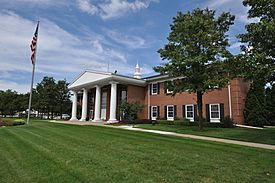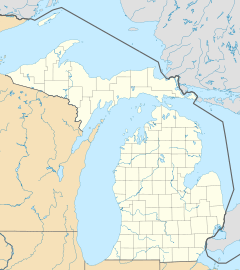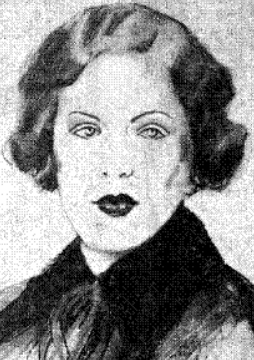Lathrup Village, Michigan facts for kids
Quick facts for kids
Lathrup Village, Michigan
|
|
|---|---|
| City of Lathrup Village | |

Lathrup Village City Hall
|
|

Location within Oakland County
|
|
| Country | United States |
| State | Michigan |
| County | Oakland |
| Organized | 1923 |
| Incorporated | 1953 |
| Government | |
| • Type | Council–manager |
| Area | |
| • City | 1.51 sq mi (3.90 km2) |
| • Land | 1.51 sq mi (3.90 km2) |
| • Water | 0.00 sq mi (0.00 km2) |
| Elevation | 705 ft (215 m) |
| Population
(2020)
|
|
| • City | 4,088 |
| • Density | 2,714.48/sq mi (1,047.74/km2) |
| • Metro | 4,296,250 (Metro Detroit) |
| Time zone | UTC-5 (EST) |
| • Summer (DST) | UTC-4 (EDT) |
| ZIP code(s) |
48076 (Southfield)
|
| Area code(s) | 248 |
| FIPS code | 26-46320 |
| GNIS feature ID | 0630184 |
The City of Lathrup Village (pronounced LAY-thrəp) is a small city in Oakland County, Michigan. It's a suburb of Detroit, located about 17 miles (27 km) north of downtown Detroit. Lathrup Village is completely surrounded by the larger city of Southfield. In 2020, about 4,088 people lived there.
Contents
A Look at Its Past
Lathrup Village started as "Lathrup Townsite," a special community created by Louise Lathrup Kelley. In 1923, she bought a large piece of land in Southfield Township. Her dream was to build a unique neighborhood.
Mrs. Kelley wanted high-quality homes built only from masonry (like brick or stone). She also made sure houses had attached garages, which was new for the time. There were rules about how much homes should cost to keep the quality high. Unfortunately, the community also had rules that prevented certain groups, like African American families, from buying homes there. This was a common but unfair practice in many areas during that time.
Louise Lathrup Kelley was very creative. She even offered a shuttle service to local shops. She also allowed people to finance cars when they bought their homes. This helped connect the townsite to other suburbs and Detroit. Her husband, Charles Kelley, helped bring talented architects to design many of the beautiful homes.
Lathrup Village officially became a city in 1953. It was the first community in Southfield Township to become incorporated. Louise Lathrup Kelley stayed involved in the city until she passed away in 1963.
Lathrup Village Historic Homes
In 1998, a big part of Lathrup Village was added to the National Register of Historic Places. This means it's recognized as an important historical area. The district includes about 1,200 homes. These homes show popular building styles from the early 1900s, such as Colonial Revival, Tudor, and Ranch houses.
The streets in Lathrup Village are designed in a mix of straight and curvy patterns. This creates interesting shapes like octagons and circles. It also makes small triangular parks throughout the area. This unique design gives the city a special feel. The Michigan State Historic Preservation Office noted that Louise Lathrup Kelley, as a woman developer in the 1920s, was quite rare. Her hard work and focus on quality created this unique community.
Where is Lathrup Village?
According to the United States Census Bureau, Lathrup Village covers about 1.50 square miles (3.90 square kilometers). All of this area is land, with no large bodies of water.
Who Lives Here?
In 2020, Lathrup Village had a population of 4,088 people. The city is home to a diverse group of residents.
- In 2020, about 30.23% of the people were White.
- About 62.33% were Black or African American.
- Smaller percentages were Native American, Asian, Pacific Islander, or from other races.
- About 3.69% of residents identified as being of two or more races.
- People of Hispanic or Latino background made up about 2.23% of the population.
In 2010, there were 1,610 households in the city. About 30.4% of these households had children under 18 living with them. The average age of residents in Lathrup Village was 45.8 years old.
Schools in the City
Lathrup Village is part of the Southfield Public School District. In the past, it was home to Southfield-Lathrup High School. Today, University High School and MacArhur K-8 School are located in Lathrup Village. Other schools in the district, like Southfield High School for the Arts & Technology, are in nearby Southfield.
Annie Lathrup School History
The Annie Lathrup School was an elementary school in Lathrup Village. It was built in 1926 and opened in 1927. The school was meant to be a central point for the community. It started with four classrooms, a kindergarten, and a gym. More classrooms were added in the 1950s. The school later became part of the Southfield Public School system and closed in the late 1970s.
The Annie Lathrup School building is the only historical landmark left in Lathrup Village. It is listed on the National Register of Historic Places. The school was named after Annie Lathrup (1861–1954), who was the mother of the city's founder, Louise Lathrup Kelley. The school's mascot was a beaver, and its sports teams were called the Lathrup Beavers.
After the school closed, it was used by a school called Yeshivat Akiva. Later, a real estate developer bought the building, hoping to build a shopping center. However, the people of Lathrup Village protested this plan. Instead, another school, The Academy of America, rented the building and opened a branch there.
Notable People
- Nick Plummer (born 1996) is a professional baseball player for the New York Mets.
See also
 In Spanish: Lathrup Village para niños
In Spanish: Lathrup Village para niños



